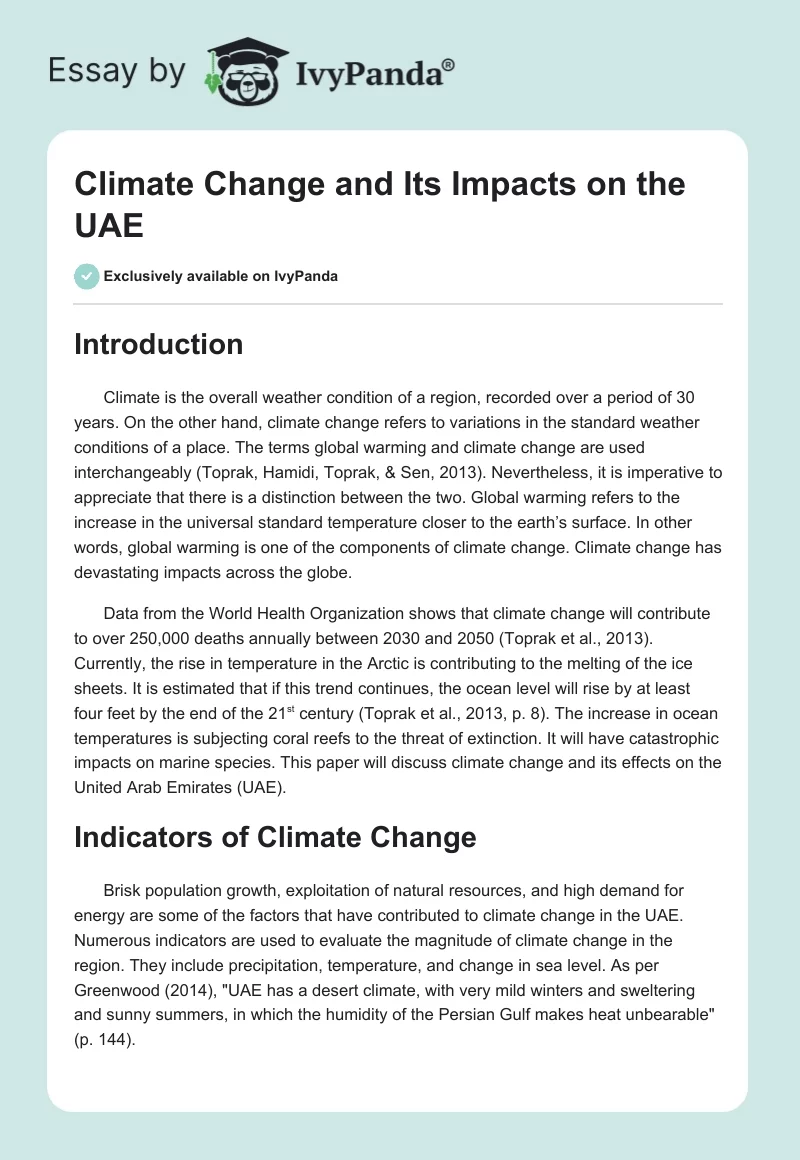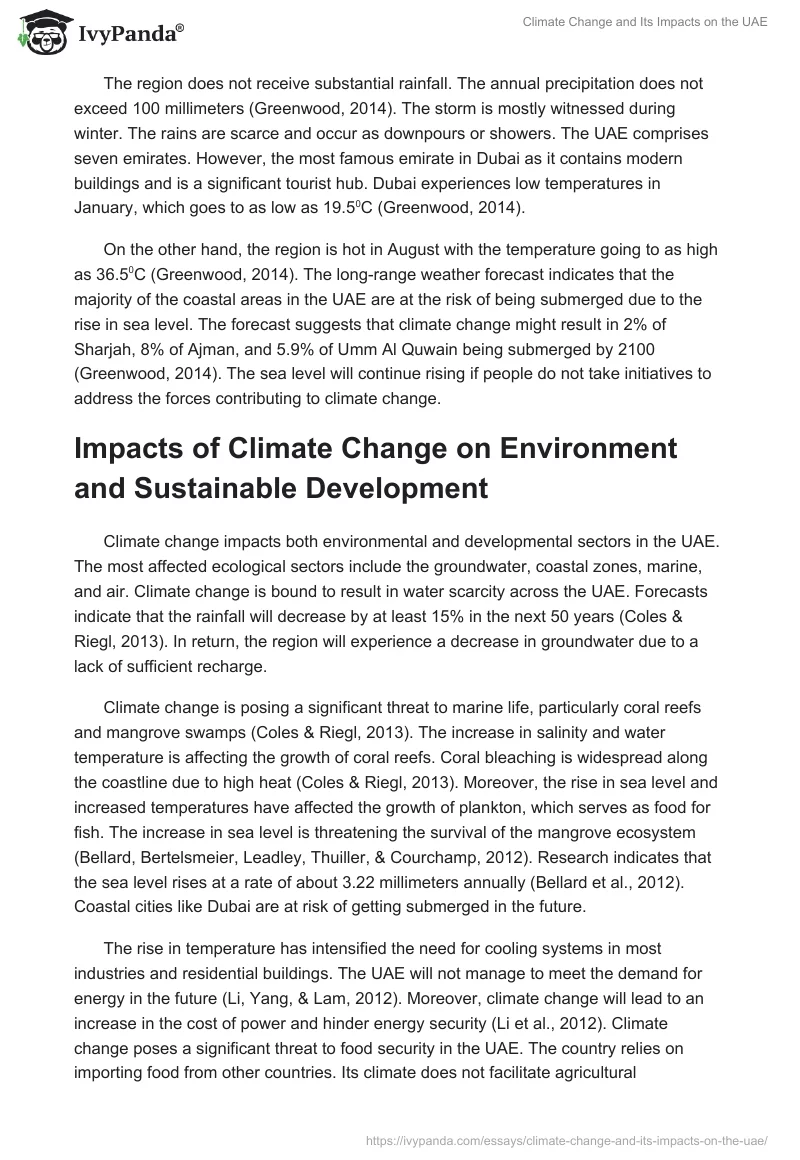Introduction
Climate is the overall weather condition of a region, recorded over a period of 30 years. On the other hand, climate change refers to variations in the standard weather conditions of a place. The terms global warming and climate change are used interchangeably (Toprak, Hamidi, Toprak, & Sen, 2013). Nevertheless, it is imperative to appreciate that there is a distinction between the two. Global warming refers to the increase in the universal standard temperature closer to the earth’s surface. In other words, global warming is one of the components of climate change. Climate change has devastating impacts across the globe.
Data from the World Health Organization shows that climate change will contribute to over 250,000 deaths annually between 2030 and 2050 (Toprak et al., 2013). Currently, the rise in temperature in the Arctic is contributing to the melting of the ice sheets. It is estimated that if this trend continues, the ocean level will rise by at least four feet by the end of the 21st century (Toprak et al., 2013, p. 8). The increase in ocean temperatures is subjecting coral reefs to the threat of extinction. It will have catastrophic impacts on marine species. This paper will discuss climate change and its effects on the United Arab Emirates (UAE).
Indicators of Climate Change
Brisk population growth, exploitation of natural resources, and high demand for energy are some of the factors that have contributed to climate change in the UAE. Numerous indicators are used to evaluate the magnitude of climate change in the region. They include precipitation, temperature, and change in sea level. As per Greenwood (2014), “UAE has a desert climate, with very mild winters and sweltering and sunny summers, in which the humidity of the Persian Gulf makes heat unbearable” (p. 144).
The region does not receive substantial rainfall. The annual precipitation does not exceed 100 millimeters (Greenwood, 2014). The storm is mostly witnessed during winter. The rains are scarce and occur as downpours or showers. The UAE comprises seven emirates. However, the most famous emirate in Dubai as it contains modern buildings and is a significant tourist hub. Dubai experiences low temperatures in January, which goes to as low as 19.5°C (Greenwood, 2014).
On the other hand, the region is hot in August with the temperature going to as high as 36.5°C (Greenwood, 2014). The long-range weather forecast indicates that the majority of the coastal areas in the UAE are at the risk of being submerged due to the rise in sea level. The forecast suggests that climate change might result in 2% of Sharjah, 8% of Ajman, and 5.9% of Umm Al Quwain being submerged by 2100 (Greenwood, 2014). The sea level will continue rising if people do not take initiatives to address the forces contributing to climate change.
Impacts of Climate Change on Environment and Sustainable Development
Climate change impacts both environmental and developmental sectors in the UAE. The most affected ecological sectors include the groundwater, coastal zones, marine, and air. Climate change is bound to result in water scarcity across the UAE. Forecasts indicate that the rainfall will decrease by at least 15% in the next 50 years (Coles & Riegl, 2013). In return, the region will experience a decrease in groundwater due to a lack of sufficient recharge.
Climate change is posing a significant threat to marine life, particularly coral reefs and mangrove swamps (Coles & Riegl, 2013). The increase in salinity and water temperature is affecting the growth of coral reefs. Coral bleaching is widespread along the coastline due to high heat (Coles & Riegl, 2013). Moreover, the rise in sea level and increased temperatures have affected the growth of plankton, which serves as food for fish. The increase in sea level is threatening the survival of the mangrove ecosystem (Bellard, Bertelsmeier, Leadley, Thuiller, & Courchamp, 2012). Research indicates that the sea level rises at a rate of about 3.22 millimeters annually (Bellard et al., 2012). Coastal cities like Dubai are at risk of getting submerged in the future.
The rise in temperature has intensified the need for cooling systems in most industries and residential buildings. The UAE will not manage to meet the demand for energy in the future (Li, Yang, & Lam, 2012). Moreover, climate change will lead to an increase in the cost of power and hinder energy security (Li et al., 2012). Climate change poses a significant threat to food security in the UAE. The country relies on importing food from other countries. Its climate does not facilitate agricultural production. Insufficient rainfall, limited arable land, and the high-temperature lender the country unproductive (Bellard et al., 2012).
Indeed, the UAE’s agricultural production caters to less than 1% of the national gross domestic product (Bellard et al., 2012). The country will continue to rely on food importation in the years to come. The increase in temperature has led to the rise in the sea levels, thus hampering the growth of the real estates and housing along the coast (Bellard et al., 2012). Sporadic floods that are attributed to climate change have impacted the safety of the beach, therefore discouraging potential real estate investors.
Impacts of Climate Change on Public Health
The earth’s physical and ecological systems have significant impacts on public health. Today, the UAE records a high number of deaths associated with heatwaves and other severe weather conditions (Teather et al., 2013). The development of urban centers and tarmac roads have led to the emergence of the “heat islands”, which contribute to people suffering from heat stress (Teather et al., 2013).
The accumulation of particulate matter and dust has led to a high number of people suffering from cardiovascular and respiratory diseases. Furthermore, “variations in temperature, precipitation, and humidity have influenced biological organisms and the processes linked to the spread of infectious diseases” (Teather et al., 2013, p. 12). Cases of dengue fever, malaria, and other air-borne diseases are on the rise due to ecological disturbances.
Efforts to Address Climate Change Risks
The UAE has come up with a strategic plan aimed at helping it to conserve the environment and mitigate the dangers of climate change. It has enacted a National Climate Change Plan intended for ensuring that the UAE embraces green sources of energy by 2050 (Treyer & Bauer, 2016). According to Treyer and Bauer (2016), the plan seeks to assist the UAE to achieve sustainable economic growth, minimize greenhouse gas emissions, and realize climate pliability. The UAE has also enacted policies like the National Green Development Strategy aimed at transforming the economy (Treyer & Bauer, 2016).
The fight against climate change should be a concerted effort between the government and the private sector. The primary challenge lies in encouraging the private sector to embrace the fight against climate change. The government has introduced incentives to encourage private institutions to participate in environmental conservation by manufacturing green products and adopting clean energy.
Conclusion
Climate change is a significant challenge across the globe. The UAE is located in a desert environment that encounters numerous problems attributed to climate change. The region receives rain during winter. The rise in sea level is putting the coastal cities at the danger of being submerged. The reduction in the amount of rainfall has led to the scarcity of groundwater in the UAE. Moreover, an increase in the temperature of the seawater is posing a threat to the survival of marine species and mangroves.
The high demand for cooling systems in residential buildings and industries will result in the UAE facing energy problems. Variations in humidity, precipitation, and temperature have created an environment that supports the spread of vector- and air-borne diseases. Additionally, the accumulation of particulate matter has led to people suffering from cardiovascular and respiratory illnesses. The UAE is implementing policies to mitigate climate change. The government has launched a campaign aimed at diversifying the economy and embracing green energy.
Recommendations
The primary cause of climate change is human activities. Thus, the UAE requires coming up with ways to coordinate efforts amid the different entities that contribute to climate change. The government should fund research and educate the public on the importance of environmental conservation. It would be hard for the UAE to realize environmental conservation goals in isolation. Therefore, it should liaise with other countries in the region to ensure that they also play their roles.
References
Bellard, C., Bertelsmeier, C., Leadley, P., Thuiller, W., & Courchamp, F. (2012). Impacts of climate change on the future of biodiversity. Ecological Letters, 15(4), 365-377.
Coles, S., & Riegl, B. (2013). Thermal tolerance of reef corals in the Gulf: A review of the potential for increasing coral survival and adaptation to climate change through assisted translocation. Marine Pollution Bulletin, 72(2), 323-332.
Greenwood, S. (2014). Water insecurity, climate change and governance in the Arab world. Middle East Policy, 21(2), 140-156.
Li, D., Yang, L., & Lam, J. (2012). Impact of climate change on energy use in the built environment in different climate zones – A review. Energy, 42(1), 103-112.
Teather, K., Hogan, N., Critchley, K., Gibson, M., Craig, S., & Hill, J. (2013). Examining the links between air quality, climate change and respiratory health in Qatar. Avicenna, 2013(1), 9-13.
Toprak, F., Hamidi, N., Toprak, S., & Sen, Z. (2013). Climatic identity assessment of the climate change. International Journal of Global Warming, 5(1), 1-17.
Treyer, K., & Bauer, C. (2016). The environmental footprint of UAE’s electricity sector: Combining life cycle assessment and scenario modeling. Energy Reviews, 55(1), 1234-1247.


